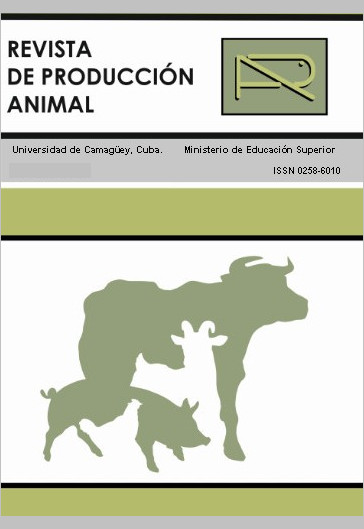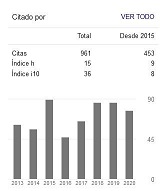Behavior of Cuban Flamingo Reproductive Indicators in Natural and Semi-confined Habitats.
Resumen
The behavior of Cuban flamingo (Phoenicopterus ruber ruber) reproductive indicators was assessed in two habitat systems: natural, at the Máximo River in Camagüey, Cuba; and semi-captive, at the San Diego Zoo, US, under similar climatic conditions (temperature and season). A randomized design was used, and the treatments were determined by the location of the habitats and the years of study (2004-2008). The percent data were altered by the square root arcsine of the proportion. Central tendency and dispersion statgraphics were developed, and variance analysis was performed using professional SPSS version 11.5.1, for Windows. The hatchability values were 87.77 and 31.73 % for Máximo River and San Diego, respectively, with significant differences (P ≤0.05); also for incubation percents (88.67 and 36.14 %, respectively. Pigeon mortality showed no significant differences, but it was high in both locations. The clear eggs and dead embryo percents were high, with significant differences between the areas under the study.Descargas
Citas
CURCÓ, A.; FRANCESC, V. y PICCARDO, J. (2007). Conservation and Management of the Greater Flamingo Phoenicopterus roseus at the Ebre Delta. En A. Béchet; M. Rendón-Martos; J. A. Amat; N. Baccetti y B. Childress (Eds.). Flamingo, (1), 37-43.
GUERRA, L. (2006). Potencial productivo de huevos clasificados como “no aptos” por su peso y forma procedentes de reproductoras White Leghorn. Te-sis de doctorado en Ciencias Veterinarias, Facultad de Ciencias Agropecuarias, Universidad de Camagüey, Cuba.
HAYMART, N. (2003). Potencial productivo del huevo clasificado como no aptas por su peso y forma procedente de reproductores ligeros. Tesis de maestría en Producción Animal Sostenible, Universidad de Camagüey, Cuba.
GUERRA, L. (2010). Comunicación personal, 16 de enero, Universidad de Camagüey, Cuba.
MÁÑEZ, M.; IBÁÑEZ, F.; GARRIDO, H.; GARCÍA, L.; ARROYO, J. L.; DEL VALLE, J. L.; CHICO, A. y RODRÍGUEZ, R. (2007). The Breeding of Greater Flamingos Phoenicopterus roseusin the Guadalquivir Marshes from 1999 to 2007. En A. Béchet, M. Rendón-Martos, J. A. Amat, N. Baccetti. y B. Childress (Eds.), Flamingo, (1), 44-47.
NISSARDI, S.; ZUCCA, C.; MURGIA, P. F. y ATZENI, A. (2007). Greater Flamingo Breeding in Sardinia: Numbers and Management Problems. En A. Béchet, M. Rendón-Martos, J. A. Amat, N. Baccet-ti. y B. Childress (Eds.), Flamingo, (1), 48-51.
PERRY, J. (2001). Reproduction. En C. Brown y C. King (Ed.), Flamingo Husbandry Guidelines. Texas, USA.
RAMESH, A. y RAMACHANDRAN, S. (2002). Factors Influencing Flamingo (Phoenicopterus roseuis) Dis-tribution in the Pulicat Lagoon Ecosystem, India. Wetlands Ecology and Management, 13(1), 69-72.
RICHARDSON, T.; PICKERING, S. y SHANNON, P. (2001). Natural History. En C. Brown. y C. King (Ed.), Flamingo Husbandry Guidelines. Texas, USA.
SABAT, P., NOVOA, F. F. y PARADA, M. (2001). Digestive Constraints and Nutrient Hydrolysis in Nes-tlings of Two Flamingo Species. Bione Online Journals. Santiago, Chile: Departamento de Cien-cias Ecológicas, Facultad de Ciencias, Universidad de Chile y Departamento de Recursos y Medio Ambiente, Minera Escondida Limitada, Antofagasta. Extraído el 27 de abril de 2010, desde http://www.bioone.org/doi/abs/10.1650./00105422(2001)103%5B0396DCANHI%5D.
SAMRAOUI, B.; OULDJAOUI, A.; HOUHAMDI, M. y SAHEB, M. (2006). The First Recorded Reproduc-tion of the Greater Flamingo Phoenicopterus ro-seusin Algeria: Behavioural and Ecological Aspects. TheJournal of African Ornithology. Extraído
el 27 de abril de 2010, desde http://www.britannica.com/bps/additionalcontent/18/23728004.
SEAWORLD EDUCATIONAL DEPARTMENT PROGRAM (2005). Flamingos. USA: Seaworld Inc.
STEVENS, E. y PICKETT, C. (1994). Managing the Social Environments of Flamingos for Reproductive Success. AZA Symposium Paper. Extraído el 23 de abril de 2010, desde http://www3.interscience.wiley.com/journal/110485640/abstractWildlifeTrust20.
ZOOLOGICAL SOCIETY OF SAN DIEGO (2008). Animal Bytes. Flamingos. Extraído el 23 de agosto de 2008, desde http://www.sandiegozoo.org/animalbytes/t-flamingo.html.
WILDLIFE TRUST (2000). Flamingos. Extraído el 12 de abril de 2010, desde http://www.the wildo-nes.org/Animals/flamingo.html.
Los autores de los artículos publicados en RPA retienen los derechos de autor de su trabajo, de marca y patente, y también sobre cualquier proceso o procedimiento descrito en el artículo, así como a compartir, copiar, distribuir, ejecutar y comunicar públicamente el artículo publicado en la RPA o cualquier parte de aquel siempre que indiquen la fuente de publicación (autores del trabajo, revista, volumen, número y fecha), pero están de acuerdo en que la revista publique los trabajos bajo una licencia Creative Commons.
![]() Licencia Attribution-NonCommercial 4.0 International (CC BY-NC 4.0)
Licencia Attribution-NonCommercial 4.0 International (CC BY-NC 4.0)






































